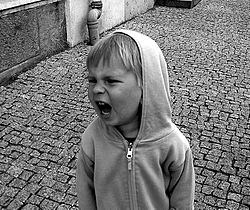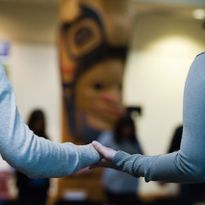LGBT Youth Suicides

Suicide attempts in LGBT (Lesbian, Gay, Bisexual, and Transgender) youth populations are significantly higher compared to heterosexual populations. One UK study found that the national average of suicide attempts is around 4.6% while the average for transgender youth is between 25% - 43% and the average for lesbian, gay, and bisexual youth is between 10% - 20%[1]. In North America, Indigenous LGBT or two-spirited youth are twice as likely to attempt suicide compared to their heterosexual indigenous counterparts[2], who have around a 18% suicide attempt rate.[3]
Research is suggesting that factors such as physical harassment, verbal harassment, sexual harassment, and familial rejection are all factors that contribute to these high rates of suicide attempts.[4] No study is able to record the number of completed suicides for LGBT youth due to the fact that coroners do not record sexual orientation.[1]
There are a number of resources available to LGBT youth, friends, and parents. The It Gets Better Project, Trevor Project, Rainbow Health Ontario, and the Canadian Centre for Gender and Sexual Diversity are all committed to providing emergency counselling to LGBT youth and to providing accurate and helpful information to the public. Studies have linked increased social support, acceptance, policy changes, and inclusivity of LGBT populations to better mental health of LGBT youth. [5][4]
Factors
Harassment

Many studies have come to the same conclusion that the most common factor that contributes to suicide attempts in LGBT youth is harassment.[4][6][7] This includes homophobic remarks, physical harassment, and sexual harassment. In support of this conclusion, the Egale Canadian Human Rights Trust conducted a survey that looked at prevalence of homophobia, biphobia, and transphobia in classrooms across Canada over one year. Regarding verbal harassment, they found that 74% of transgender students and 55% of lesbian, bisexual, and gay students were verbally harassed about their gender expression and their sexuality. With physical harassment, 1 in 5 lesbian, bisexual, and gay students reported being physically harassed due to their sexual orientation. In addition, 37% of transgender students reported being harassed due to their gender expression. Lastly, with sexual harassment, 40%-50% of all LGBT students reported being sexually harassed.[8] These statistics show that at school, where a LGBT youth would be spending the majority of their days, they are exposed to high levels of harassment that have a detrimental effect on their mental health. The constant harassment leads to feelings of worthlessness, self-loathing, isolation, and disgust which all contribute to suicidal ideation[4].
Rejection

One challenge of many that LGBT youth have to deal with is coming out to their family and friends.[4][6][9] Coming out is when you reveal your sexual identity to others. This event can be troubling, especially if they are raised in environments that are unaccepting of LGBT people, such as in traditional religious families. A US study found that among LGBT youth that have attempted suicide, about 48% were rejected by their fathers and 28% were rejected by their mothers.[9] Rejection from family, coupled with harassment at school can lead LGBT youth to have no space where they are not judged for their sexuality. Furthermore, if the parents feel strongly about the sexuality of their child, they can kick their child out of their residence. A UCLA survey of homeless youth in America showed that LGBT Youth make up about 30-40% of the homeless youth population and that almost 70% ran away or were kicked out because of their sexual identity.[10] Coming out is something that most, if not all, LGBT youth have to deal with. If the parents are not accepting of their sexuality, the accumulation of harassment at school and rejection by their family can increase the likelihood of a suicide attempt.
LGBT Indigenous Youth Suicide

In Canada, Indigenous youth have an alarmingly high suicide rate compared to the national average. The Innu in the Davis Inlet, Newfoundland, the Indigenous youth have a suicide rate of around 17.8% while the national average is around 1.2%.[3] In British Columbia, aboriginal boys are 8 times as likely to commit suicide compared to their non-indigenous peers and girls are 20 times as likely.[3] These high rates of suicide are hypothesized to be due to the loss of culture and systemic discrimination that many Indigenous people in Canada have endured.[11] LGBT or two-spirited Indigenous youth are twice as likely to attempt suicide compared to heterosexual Indigenous youth.[2] The reasoning for this can be dissected using an intersectional approach. As mentioned before, Indigenous people have endured a loss of culture and discrimination from Canadian people and the government. Already not being accepted by society, Indigenous LGBT youth have harassment from peers and rejection by their family to worry about. This compounding of factors increases the likelihood of suicidal ideation, self harm, and suicide attempts. This multitude of factors cannot be disentangled, and all must be considered when analyzing this subject.
Preventative Measures
Social Support
One method that was shown to strongly counteract suicidal ideation in LGBT youth was presence of strong social support. Having family and friends who support you and your sexuality can provide safe spaces that can be used to counteract harassment and rejection from others. [4][6] A longitudinal study looking at life outcomes of LGBT youth found that victimization and psychological distress does decrease as LGBT youth progress into adulthood. In addition, reduction in these detrimental factors is helped tremendously by positive social support. [5]
Inclusivity
Gay Straight Alliances

Having a school community that has reduced rates of harassment and discrimination has positive outcomes on the mental wellbeing of LGBT youth. One way that school administrations can foster this is by having Gay-Straight Alliances. The Egale report recommends that schools have Gay-Straight Alliances to not only promote a safe and inclusive space for all, but to also for LGBT youth to have similar peers to reduce feelings of isolation. [8]
Finding LGBT Communities
Having peers who are also LGBT youth can help protect against the factors that contribute to LGBT youth suicidal ideation. Projects like the It Gets Better movement aim to show LGBT youth that although they may feel alone and isolated in these situations, there are other just like them that are willing to support them for who they are. A study that looked at the effectiveness of these types of movements showed that they are indeed helping, but earlier interventions are needed in order to promote better psychological health. [6]
Resources for LGBT Youth and Families
It Gets Better Project - https://itgetsbetter.org/
The Trevor Project - https://www.thetrevorproject.org/
The Canadian Centre for Gender and Sexual Diversity - http://ccgsd-ccdgs.org/
OCASI (Ontario Council of Agencies Serving Immigrants) - http://positivespaces.ca/
Families in TRANSition: A Resource Guide for Parents of Trans Youth - https://www.rainbowhealthontario.ca/resources/families-in-transition-a-resource-guide-for-parents-of-trans-youth/
References
- ↑ 1.0 1.1 Haas, A. P., Rodgers, P. L., & Herman, J. L. (2014). Suicide Attempts among Transgender and Gender Non ... Retrieved from http://williamsinstitute.law.ucla.edu/wp-content/uploads/AFSP-Williams-Suicide-Report-Final.pdf
- ↑ 2.0 2.1 First Nations Centre (2012). Suicide prevention and two-spirited people. Ottawa: National Aboriginal Health Organization
- ↑ 3.0 3.1 3.2 Ferry, Jon (March 11, 2000). "No easy answer to high native suicide rates". The Lancet.
- ↑ 4.0 4.1 4.2 4.3 4.4 4.5 Rivers, I., Gonzalez, C., Nodin, N., Peel, E., & Tyler, A. (2018). LGBT people and suicidality in youth: A qualitative study of perceptions of risk and protective circumstances. Social Science and Medicine, 212(October 2017), 1–8. http://doi.org/10.1016/j.socscimed.2018.06.040
- ↑ 5.0 5.1 Liu, R. T., & Mustanski, B. (2012). Suicidal ideation and self-harm in lesbian, gay, bisexual, and transgender youth. American Journal of Preventive Medicine, 42(3), 221–228. http://doi.org/10.1016/j.amepre.2011.10.023
- ↑ 6.0 6.1 6.2 6.3 Birkett, M., Newcomb, M. E., & Mustanski, B. (2015). Does it get better? a longitudinal analysis of psychological distress and victimization in lesbian, gay, bisexual, transgender, and questioning youth. Journal of Adolescent Health, 56(3), 280–285. http://doi.org/10.1016/j.jadohealth.2014.10.275
- ↑ McDermott, E., Roen, K., & Scourfield, J. (2008). Avoiding shame: Young LGBT people, homophobia and self-destructive behaviours. Culture, Health and Sexuality, 10(8), 815–829. http://doi.org/10.1080/13691050802380974
- ↑ 8.0 8.1 Taylor, C. & Peter, T., with McMinn, T.L., Elliott, T., Beldom, S., Ferry, A., Gross, Z., Paquin, S., & Schachter, K. (2011). Every class in every school: The first national climate survey on homophobia, biphobia, and transphobia in Canadian schools. Final report. Toronto, ON: Egale Canada Human Rights Trust.
- ↑ 9.0 9.1 D’Augelli, A. R., Hershberger, S. L., & Pilkington, N. W. (2003). Suicidality Patterns and Sexual Orientation-Related Factors Among Lesbian, Gay, and Bisexual Youths. Suicide and Life-Threatening Behavior. http://doi.org/10.1521/suli.31.3.250.24246
- ↑ Durso, L. E., & Gates, G. J. (2012). Serving Our Youth: Findings from a National Survey of Services Providers Working with Lesbian, Gay, Bisexual and Transgender Youth Who Are Homeless or At Risk of Becoming Homeless. Retrieved from https://escholarship.org/uc/item/80x75033
- ↑ Chandler, M. J., & Lalonde, C. (1998). Cultural Continuity as a Hedge against Suicide in Canada’s First Nations. Transcultural Psychiatry. http://doi.org/10.1177/136346159803500202